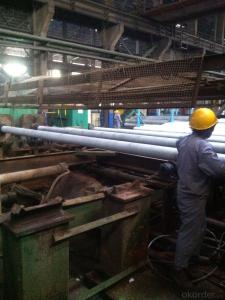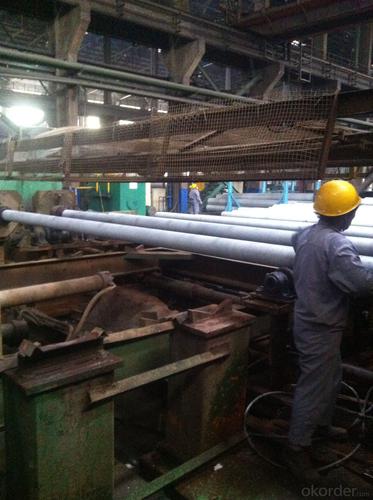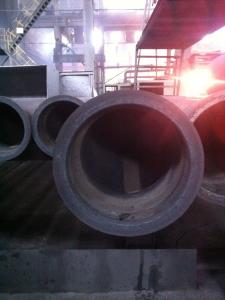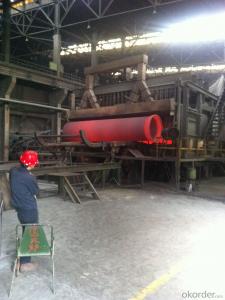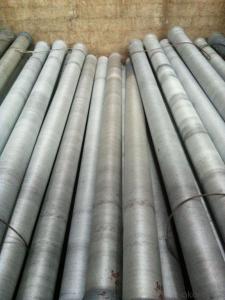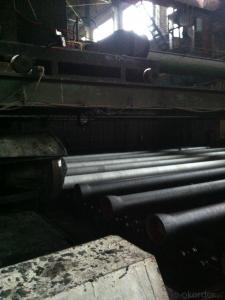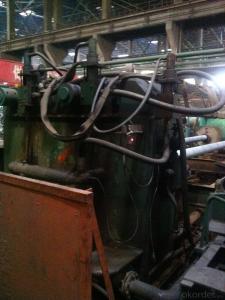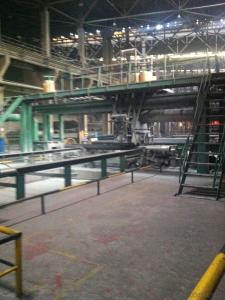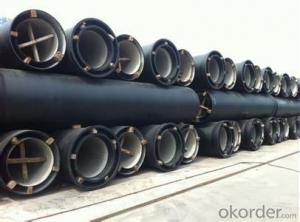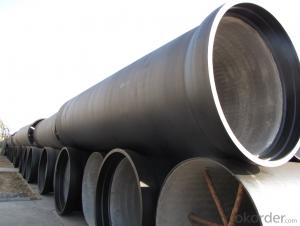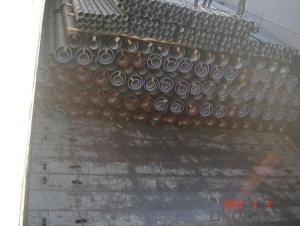DUCTILE IRON PIPE AND PIPE FITTINGS K9 CLASS DN900
- Loading Port:
- Tianjin
- Payment Terms:
- TT OR LC
- Min Order Qty:
- 21 pc
- Supply Capability:
- 3000 pc/month
OKorder Service Pledge
OKorder Financial Service
You Might Also Like
Material : Ductile Cast Iron
Size Range : DN 80mm to DN 2000mm
Unit Effective Length : 6m or 5.7m
Manufacture Standard: ISO 2531:1998/ EN 545:2006/EN 598:2007
Annual capacity : 200,000 tons
Coating Exterior: Zinc 130g/m2 according to ISO 8179-1 and bitumen coating 70 microns.
Cement Interior: Portland Cement/ High Alumina Cement/ Sulphate Resisting Cement Lining according to ISO 4179
Special requirements on external coating and internal lining can be applied
We also provide accessories such as SBR/EPDM rubber gaskets, lubricant paste, pipe caps, PE sleeves, etc.
Additional Parts:
Each pipe is strictly inspected according to related standard to ensure permanently high performance.
Easy Installation at site and service free for life
Long Service Lifespan
Quotation will arrive you within 24hours once we get your inquiry.
We guarantee offering you a competitive price.
A copy of original inspection reports of pipes will be offered after shipment.
Photos of loading process will be sent to the customer after shipment effect.
We will follow-up the delivery progress after shipment effect and update to the customer on weekly basis.
- Q: How are ductile iron pipes protected against external corrosion?
- Ductile iron pipes are protected against external corrosion through the application of protective coatings such as polyethylene, epoxy, or zinc. These coatings act as a barrier between the pipe and the surrounding environment, preventing contact with corrosive elements such as water, soil, or chemicals. Additionally, cathodic protection techniques, such as sacrificial anodes or impressed current systems, may also be employed to further enhance the corrosion resistance of ductile iron pipes.
- Q: Does the cast iron pipe for spheroidal graphite need corrosion protection when laying underground?
- Ductile cast iron pipe after annealing, the microstructure is ferrite and pearlite, good mechanical properties, excellent corrosion resistance, good ductility, good sealing effect, simple installation, mainly for municipal, industrial and mining enterprises, water supply, gas, oil etc..
- Q: How do ductile iron pipes handle soil movement?
- Ductile iron pipes are renowned for their exceptional strength and durability, rendering them highly adept at managing soil movement. These pipes are engineered to withstand the external loads and pressures arising from soil settlement, ground shifting, or other environmental elements. A significant characteristic of ductile iron pipes lies in their flexibility. Unlike inflexible materials such as cast iron or concrete pipes, ductile iron pipes possess a certain degree of elasticity, enabling them to endure soil movement without succumbing to cracks or fractures. This flexibility empowers the pipes to absorb the stresses imposed by the soil, effectively preventing any substantial harm to the pipeline system. Furthermore, ductile iron pipes exhibit remarkable tensile strength, allowing them to resist the pulling forces that arise from soil movement. The pipes can endure the expansion and contraction of the surrounding soil, thereby diminishing the likelihood of pipe deformation or failure. Additionally, ductile iron pipes are frequently installed using proper bedding and backfilling techniques to further enhance their capacity to handle soil movement. Adequate bedding materials, such as crushed stone or sand, are utilized to deliver stable support to the pipes and distribute the external loads uniformly. This serves to minimize the impact of soil movement on the pipes and uphold their structural integrity. In conclusion, ductile iron pipes are purposefully designed to proficiently manage soil movement by virtue of their flexibility, high tensile strength, and appropriate installation methods. These pipes can effectively endure the stresses generated by soil settlement, ground shifting, or other soil-related factors, ensuring dependable and long-lasting performance in a variety of environmental conditions.
- Q: How do ductile iron pipes handle dynamic loads?
- Ductile iron pipes are well-suited to handle dynamic loads due to their high tensile strength and flexibility. The inherent ductility of the material allows the pipes to withstand the stress and strain caused by dynamic loads, such as water hammer or ground movement, without fracturing or breaking. This makes them a reliable choice for applications where frequent load variations or transient events are expected.
- Q: Can ductile iron pipes be used for underground slurry pipelines?
- Underground slurry pipelines can utilize ductile iron pipes, as they possess strength, durability, and resistance to corrosion, making them suitable for various applications. Their qualities make them reliable and cost-effective in transporting mixtures of solids and liquids over long distances. Ductile iron pipes can endure the abrasive nature of slurry and the external loads associated with underground installation, owing to their inherent toughness and flexibility. Moreover, they can be easily connected through different methods, ensuring a secure and leak-free pipeline system. Nonetheless, it is crucial to assess the specific properties of the slurry being transported and seek professional advice to determine the suitable pipe specifications and design considerations for the underground slurry pipeline.
- Q: What is the expected hydraulic efficiency of ductile iron pipes?
- The expected hydraulic efficiency of ductile iron pipes is generally high, as they have a smooth interior surface that minimizes friction and allows for efficient flow of water or other fluids.
- Q: Are ductile iron pipes suitable for use in mining tailings pipelines?
- Yes, ductile iron pipes are suitable for use in mining tailings pipelines. Ductile iron pipes have excellent strength and durability, making them capable of withstanding the harsh and abrasive conditions often found in mining operations. They have high tensile strength, which allows them to handle the pressure and weight of the tailings material. Additionally, ductile iron pipes have good resistance to corrosion, which is important in a mining environment where the tailings may contain chemicals or other substances that can be corrosive. Furthermore, ductile iron pipes are known for their ease of installation and maintenance, which can be advantageous in mining operations where time is crucial. Overall, ductile iron pipes are a reliable and cost-effective choice for mining tailings pipelines.
- Q: Can ductile iron pipes be used in underground installations?
- Indeed, underground installations can utilize ductile iron pipes. These pipes are frequently employed in a multitude of subterranean scenarios, such as water distribution systems, sewer systems, and underground fire mains. Their notable attributes encompass robustness, endurance, and resistance to both external strains and corrosion, rendering them fitting for underground installations. Moreover, ductile iron pipes exhibit remarkable adaptability to ground movements and possess the capacity to endure substantial traffic loads. Consequently, they represent a dependable option for underground installations, particularly when stability and longevity emerge as pivotal considerations.
- Q: What is the process of fusion bonding for ductile iron pipes?
- The process of fusion bonding for ductile iron pipes involves joining two or more pipes together using heat and pressure to create a strong and durable bond. This technique is particularly used in the construction and installation of underground water, sewer, and gas pipelines. The first step in the fusion bonding process is to clean and prepare the surfaces of the pipes to be joined. This involves removing any dirt, debris, or rust that may interfere with proper bonding. Specialized cleaning tools and techniques, such as wire brushing or sandblasting, are often employed to ensure a clean and smooth surface. Once the surfaces are prepared, the pipes are aligned and clamped together. A fusion bonding machine, also known as a fusion welder, is then used to apply heat and pressure to the joint area. The fusion bonding machine consists of heating elements that are positioned around the joint and a hydraulic system that applies the necessary pressure. The heating elements are typically electric or gas-powered and are designed to reach temperatures high enough to melt the ductile iron material. As the heat is applied, the ductile iron surfaces begin to soften and fuse together, creating a strong bond. The pressure from the fusion bonding machine ensures that the molten iron flows evenly and uniformly between the joint surfaces, promoting a seamless connection. The duration of the fusion bonding process varies depending on the size and thickness of the pipes, as well as the specific requirements of the project. Once the fusion bonding is complete, the joint is allowed to cool and solidify, forming a permanent and leak-proof connection. Fusion bonding offers several advantages for ductile iron pipes. It provides a reliable and durable joint that can withstand high pressure, temperature variations, and external loads. The seamless connection also minimizes the risk of leaks, which is crucial for underground pipelines that transport water, sewage, or gas. Overall, fusion bonding is a widely used technique for joining ductile iron pipes, ensuring their structural integrity and longevity in various infrastructure projects.
- Q: Is there a kind of pipe called lined ductile iron pipe? Seeking manufacturers?
- This is basically used as drainage, ie the launching system. The fittings they use are different. You can use specific Baidu search or check, Suzhou arhccom Pipe Industry Co. Ltd., which specializes in Jiangsu ductile plastic lined pipe, ductile iron pipe and fittings. You say there are many manufacturers, they specialize in doing your jade lining plastic ductile iron pipe (second line brand), the new lining plastic ductile iron pipe (brand). Hope to help you.
Send your message to us
DUCTILE IRON PIPE AND PIPE FITTINGS K9 CLASS DN900
- Loading Port:
- Tianjin
- Payment Terms:
- TT OR LC
- Min Order Qty:
- 21 pc
- Supply Capability:
- 3000 pc/month
OKorder Service Pledge
OKorder Financial Service
Similar products
Hot products
Hot Searches
Related keywords
